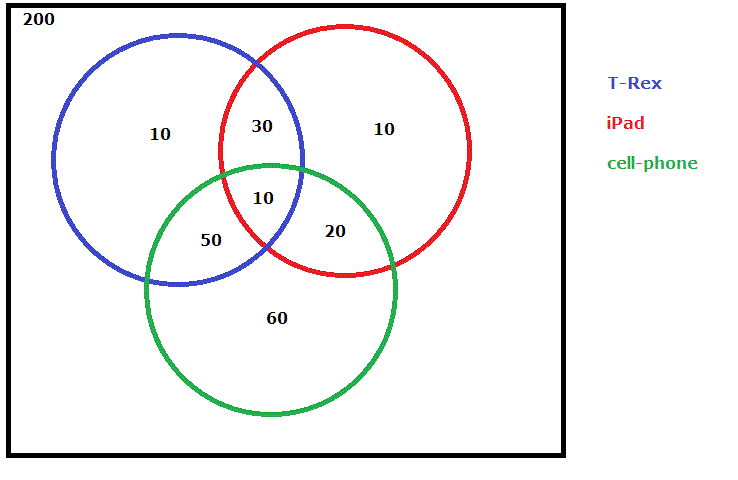#10# students have all three.
~~~~~~~~~~~~~~~~~~~~~~~~~~~~~~~~~~~
Of the #40# students who have a T-Rex and an iPad, #10# students also have a cell phone (they have all three). So #30# students have a T-Rex and an iPad but not all three.
Of the #30# students who had an iPad and a cell-phone, #10# students have all three. So #20# student have an iPad and a cell-phone but not all three.
Of the #60# students who had a T-Rex and a cell-phone, #10# students have all three. So #50# students have a T-Rex and a cell-phone but not all three.
~~~~~~~~~~~~~~~~~~~~~~~~~~~~~~~~~~~
Of the #100# students who have a T-Rex, #10# have all three, #30# also have (only) an iPad, and #50# also have (only) a cell-phone.
So #100-(10+30+50)=10# have only a T-Rex.
Similarly, #70-(10+30+20)=10# have only an iPad.
And #140-(10+20+50)=60# have only a cell-phone.
~~~~~~~~~~~~~~~~~~~~~~~~~~~~~~~~~~~
#{:
("T-Rex","iPad","cell-phone",,"number of students"),
("Y","Y","Y",,10),
("Y","Y","N",,30),
("N","Y","Y",,20),
("Y","N","Y",,50),
("Y","N","N",,10),
("N","Y","N",,10),
("N","N","Y",,60),
(,,,"total:",190)
:}#
So out of #200# students #190# have at least one of these devices.
#rArr 200-190=10# students do not have any of these devices.
Here is how the distribution would appear in a Venn diagram:


